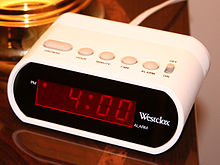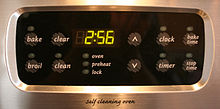Digital clock

A digital clock is a type of clock that displays the time digitally, i.e. in cyphers, as opposed to an analog clock, where the time is displayed by hands. Usually, digital clocks are associated with electronic drives, but the "digital" description refers only to the display, not to the drive mechanism. (Analog clocks are driven mechanically or electronically.) The biggest digital clock is the Lichtzeitpegel ("Light Time Level") on the television tower Rheinturm Düsseldorf, Germany.
Construction
Digital clocks typically use the 50 or 60 hertz oscillation of AC power or a 32,768 hertz crystal oscillator as in a quartz clock to keep time. Most digital clocks display the hour of the day in 24 hour format; in the United States and a few other countries, a more commonly used hour sequence is 12 hour format (with some indication of AM or PM). Some clocks can display either time mode according to the owner's preference. Emulations of analog-style faces often use an LCD screen, and these are also sometimes described as "digital".
Displays


To represent the time, most digital clocks use a seven-segment LED, VFD, or LCD display for each of four digits. They generally also include other elements to indicate whether the time is AM or PM, whether or not an alarm is set, and so on.
Setting


Since they run on electricity, digital clocks must be reset every time the power is cut off. This is a particular problem with alarm clocks that have no "battery" backup, because even a very brief power outage during the night usually results in the clock failing to trigger the alarm in the morning.
To reduce the problem, many devices designed to operate on household electricity incorporate a battery backup to maintain the time during power outages and during times of disconnection from the power supply. More recently, some devices incorporate a method for automatically setting the time, such as using a broadcast radio time signal from an atomic clock, getting the time from an existing satellite television or computer connection, or by being set at the factory and then maintaining the time from then on with a quartz movement powered by an internal rechargeable battery.
Uses

- Because digital clocks can be very small and inexpensive devices that enhance the popularity of product designs, they are often incorporated into all kinds of devices such as cars, radios, televisions, microwave ovens, standard ovens, computers and cell phones. Sometimes their usefulness is disputed: a common complaint is that when time has to be set to Daylight Saving Time, many household clocks have to be readjusted. The incorporation of automatic synchronisation by a radio time signal is reducing this problem (see Radio clock).
External links
- How Digital Clocks Work
- History of the Digital Watch
- Time Associations: Associations we have with numbers on a digital clock
